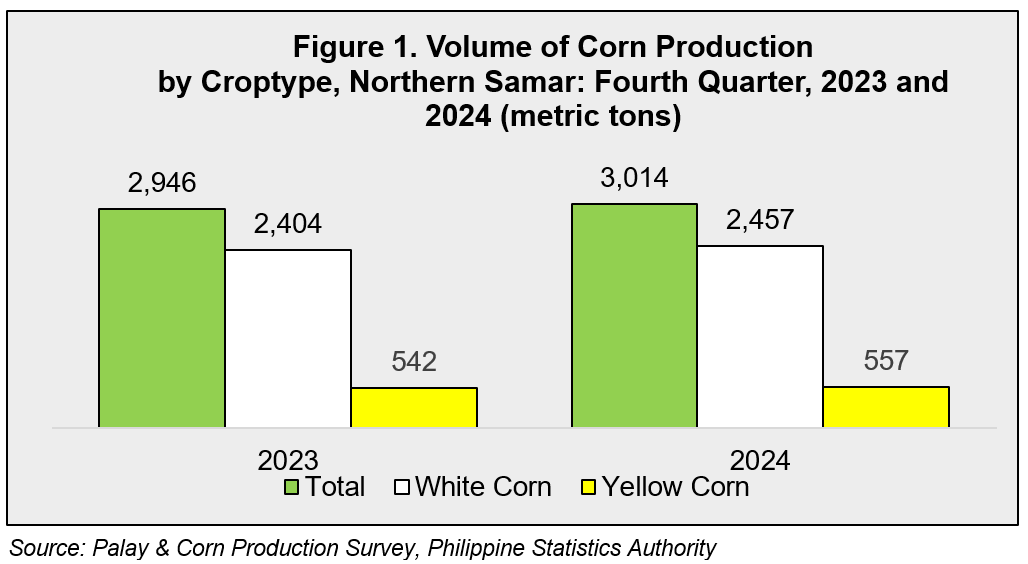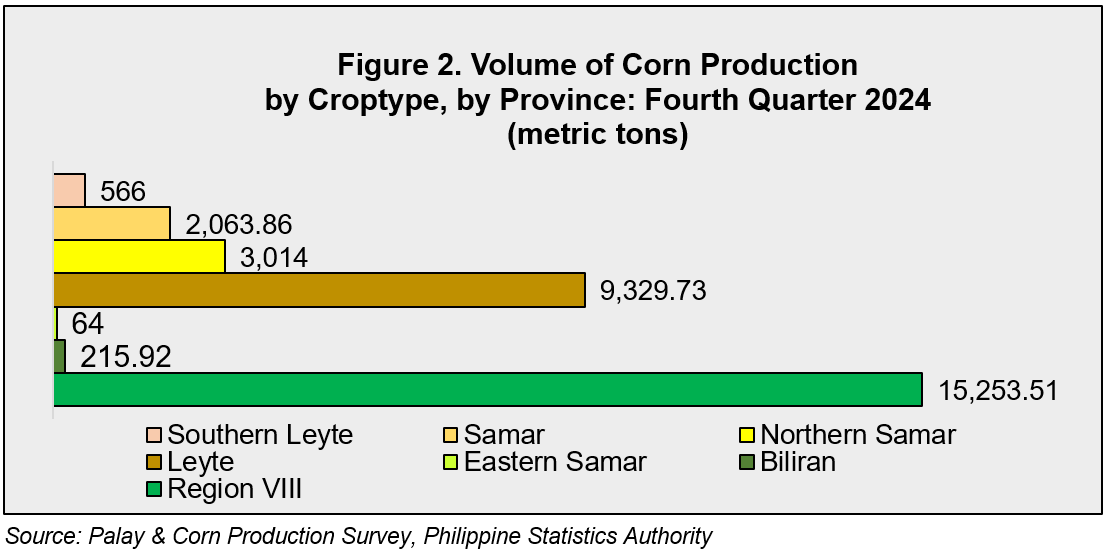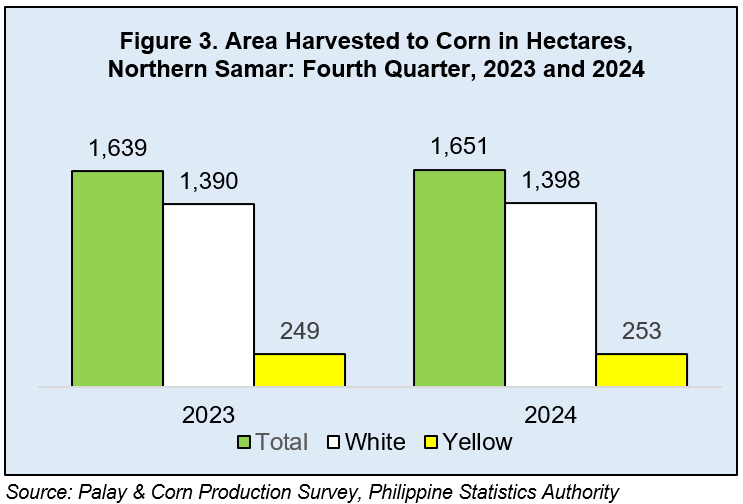The Philippine Statistics Authority (PSA) releases the results of the corn production and harvested area in the province for the fourth quarter of 2024, based on the latest data collected through the Palay and Corn Production Survey (PCPS). This quarterly survey generates estimates on production volume, yield per hectare, and total area harvested for both palay and corn.
In the fourth quarter of 2024, Northern Samar’s corn production increased by
2.31 percent compared to the same period in 2023, from 2,946 metric tons in fourth quarter 2023 to 3,014 metric tons in fourth quarter of 2024. Marking an addition of 68 metric tons year-on-year.
Table 1. Volume of Corn Production in Northern Samar
Fourth Quarter of 2023 & 2024

Figure 1 shows that white corn remained the dominant variety in the province, with production increasing from 2,404 metric tons in the fourth quarter of 2023 to 2,457 metric tons in the same period of 2024, representing a 2.2 percent increase or an additional 53 metric tons. Meanwhile, yellow corn production also saw a slight increase, rising from 542 metric tons in 2023 to 557 metric tons in 2024, which reflects a 2.8 percent increase.
With this, Northern Samar presented a slow yet steady increase in corn production during the fourth quarter of 2024, with an overall increase of 68 metric tons or
2.31 percent compared to the same period in 2023. The consistent rise in output implicates positive developments in agricultural practices or conditions in the province, contributing to enhanced food security and potential economic benefits to local farmers.

In the fourth quarter of 2024, Region VIII recorded a total corn production of 15,253.51 metric tons. Among its provinces, Leyte appeared as the top producer with 9,329.73 metric tons, accounting for approximately 61.16 percent of the region’s total production. This was followed by Northern Samar with 3,014 metric tons (19.76 percent) and Samar with 2,063.86 metric tons (13.53 percent). These three provinces collectively contributed over 94.45 percent of the regional total production. In contrast, Southern Leyte produced 566 metric tons, while Biliran and Eastern Samar had significantly lower productions at 215.92 and 64 metric tons, respectively, contributing less than 2 percent each. The notable gap in production across provinces suggests the need for targeted interventions—such as enhanced access to technology, inputs, or infrastructure—in lower-performing areas, while high-producing provinces like Leyte and Northern Samar show strong potential for further agricultural development and expansion.

Figure 3 presents a quarterly comparison of the total area harvested for corn in 2023 and 2024, disaggregated into white and yellow corn varieties. The data indicates an increase in the harvested area for all corn types during the fourth quarter.
The total area harvested to corn increased from 1,639 hectares in the previous year of the same quarter to 1,651 hectares in the fourth quarter of 2024, marking a growth of 12 hectares or about 0.73 percent. This slight increase may reflect improved growing conditions, enhanced planting efforts, or an overall positive shift in corn production practices during the period.
The area harvested for white corn increased from 1,390 hectares to 1,398 hectares, an increase of 8 hectares, equivalent to a 0.58 percent growth. This increase suggests a steady demand for white corn, which is typically associated with household consumption or local food supply.
Meanwhile, yellow corn recorded an increase from 249 hectares to 253 hectares, representing a 1.61 percent increase or 4 hectares. Although smaller in total area compared to white corn, the higher percentage increase for yellow corn could indicate a growing interest in its cultivation, potentially driven by its use in livestock feed and industrial purposes.

Overall, while the increases in harvested area are relatively increase, the consistent upward trend across both corn types indicates a stable or slightly expanding corn industry. These changes, though small, may also reflect localized improvements in agricultural support, access to inputs, or favorable weather conditions.
FOR THE CHIEF STATISTICAL SPECIALIST:
GINA G. ORTEGO (SGD.)
Supervising Statistical Specialist
STATISTICAL TABLES
TABLE 2. Corn: Volume of Production in Metric Tons by Crop type, by Crop type, Fourth Quarter, Northern Samar, 2024

TABLE 3. Corn: Area Harvested in Hectares by Crop type, Fourth Quarter, Northern Samar, 2024

TECHNICAL NOTES
Corn production & area and other production data are generated from Corn Production Survey (CPS) which is one of the major agricultural surveys of the Philippine Statistics Authority (PSA). The CPS is conducted nationwide every quarter of each year. It aims to generate estimates that serve as inputs for policy making and programs on corn. Production data generated from the CPS are inputs to the Performance of Agriculture Report (PAR) and preparation of the Gross Domestic Product (GDP).
• Production – refers to quantity produced and actually harvested during reference period. It includes those harvested but damaged, stolen, given away, consumed, given as harvesters’ and threshers’ shares, reserved, etc. Corn production from seed growers which are intended for seed purposes is excluded from the survey.
• White Corn – this type of corn is used primarily for human consumption.
• Yellow Corn – this type of corn is used generally as feed grains. They include all types of corn other than white.

